Shixuan Li
VeriMoA: A Mixture-of-Agents Framework for Spec-to-HDL Generation
Oct 31, 2025Abstract:Automation of Register Transfer Level (RTL) design can help developers meet increasing computational demands. Large Language Models (LLMs) show promise for Hardware Description Language (HDL) generation, but face challenges due to limited parametric knowledge and domain-specific constraints. While prompt engineering and fine-tuning have limitations in knowledge coverage and training costs, multi-agent architectures offer a training-free paradigm to enhance reasoning through collaborative generation. However, current multi-agent approaches suffer from two critical deficiencies: susceptibility to noise propagation and constrained reasoning space exploration. We propose VeriMoA, a training-free mixture-of-agents (MoA) framework with two synergistic innovations. First, a quality-guided caching mechanism to maintain all intermediate HDL outputs and enables quality-based ranking and selection across the entire generation process, encouraging knowledge accumulation over layers of reasoning. Second, a multi-path generation strategy that leverages C++ and Python as intermediate representations, decomposing specification-to-HDL translation into two-stage processes that exploit LLM fluency in high-resource languages while promoting solution diversity. Comprehensive experiments on VerilogEval 2.0 and RTLLM 2.0 benchmarks demonstrate that VeriMoA achieves 15--30% improvements in Pass@1 across diverse LLM backbones, especially enabling smaller models to match larger models and fine-tuned alternatives without requiring costly training.
H$^2$GFM: Towards unifying Homogeneity and Heterogeneity on Text-Attributed Graphs
Jun 10, 2025Abstract:The growing interests and applications of graph learning in diverse domains have propelled the development of a unified model generalizing well across different graphs and tasks, known as the Graph Foundation Model (GFM). Existing research has leveraged text-attributed graphs (TAGs) to tackle the heterogeneity in node features among graphs. However, they primarily focus on homogeneous TAGs (HoTAGs), leaving heterogeneous TAGs (HeTAGs), where multiple types of nodes/edges reside, underexplored. To enhance the capabilities and applications of GFM, we introduce H$^2$GFM, a novel framework designed to generalize across both HoTAGs and HeTAGs. Our model projects diverse meta-relations among graphs under a unified textual space, and employs a context encoding to capture spatial and higher-order semantic relationships. To achieve robust node representations, we propose a novel context-adaptive graph transformer (CGT), effectively capturing information from both context neighbors and their relationships. Furthermore, we employ a mixture of CGT experts to capture the heterogeneity in structural patterns among graph types. Comprehensive experiments on a wide range of HoTAGs and HeTAGs as well as learning scenarios demonstrate the effectiveness of our model.
HDLCoRe: A Training-Free Framework for Mitigating Hallucinations in LLM-Generated HDL
Mar 18, 2025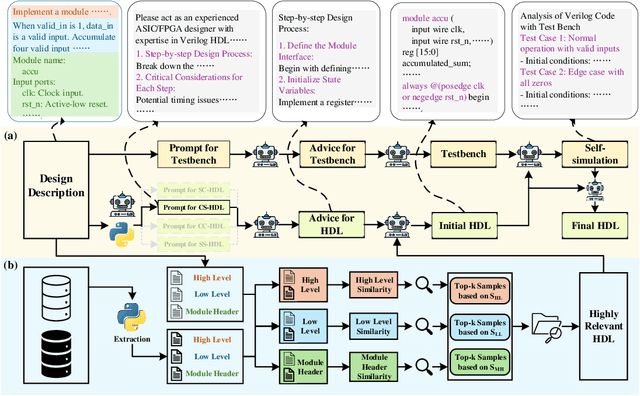



Abstract:Recent advances in large language models (LLMs) have demonstrated remarkable capabilities in code generation tasks. However, when applied to hardware description languages (HDL), these models exhibit significant limitations due to data scarcity, resulting in hallucinations and incorrect code generation. To address these challenges, we propose HDLCoRe, a training-free framework that enhances LLMs' HDL generation capabilities through prompt engineering techniques and retrieval-augmented generation (RAG). Our approach consists of two main components: (1) an HDL-aware Chain-of-Thought (CoT) prompting technique with self-verification that classifies tasks by complexity and type, incorporates domain-specific knowledge, and guides LLMs through step-by-step self-simulation for error correction; and (2) a two-stage heterogeneous RAG system that addresses formatting inconsistencies through key component extraction and efficiently retrieves relevant HDL examples through sequential filtering and re-ranking. HDLCoRe eliminates the need for model fine-tuning while substantially improving LLMs' HDL generation capabilities. Experimental results demonstrate that our framework achieves superior performance on the RTLLM2.0 benchmark, significantly reducing hallucinations and improving both syntactic and functional correctness.
End-to-End Learning Framework for Solving Non-Markovian Optimal Control
Feb 07, 2025Abstract:Integer-order calculus often falls short in capturing the long-range dependencies and memory effects found in many real-world processes. Fractional calculus addresses these gaps via fractional-order integrals and derivatives, but fractional-order dynamical systems pose substantial challenges in system identification and optimal control due to the lack of standard control methodologies. In this paper, we theoretically derive the optimal control via \textit{linear quadratic regulator} (LQR) for \textit{fractional-order linear time-invariant }(FOLTI) systems and develop an end-to-end deep learning framework based on this theoretical foundation. Our approach establishes a rigorous mathematical model, derives analytical solutions, and incorporates deep learning to achieve data-driven optimal control of FOLTI systems. Our key contributions include: (i) proposing an innovative system identification method control strategy for FOLTI systems, (ii) developing the first end-to-end data-driven learning framework, \textbf{F}ractional-\textbf{O}rder \textbf{L}earning for \textbf{O}ptimal \textbf{C}ontrol (FOLOC), that learns control policies from observed trajectories, and (iii) deriving a theoretical analysis of sample complexity to quantify the number of samples required for accurate optimal control in complex real-world problems. Experimental results indicate that our method accurately approximates fractional-order system behaviors without relying on Gaussian noise assumptions, pointing to promising avenues for advanced optimal control.
Multi-scale Generative Modeling for Fast Sampling
Nov 14, 2024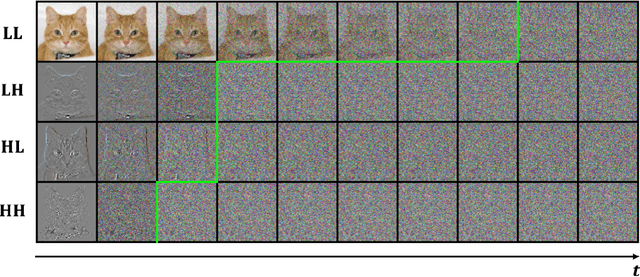

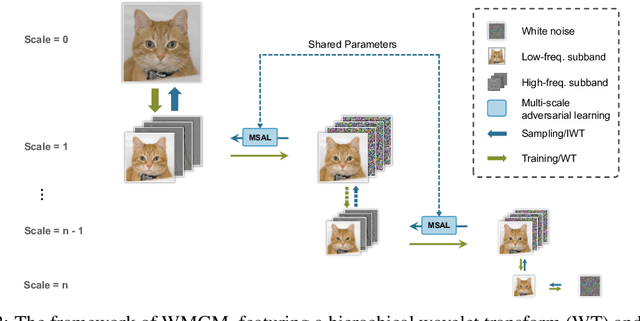
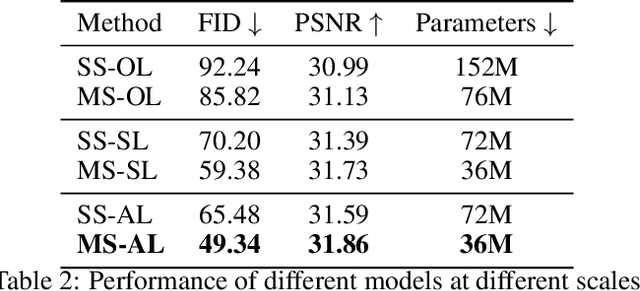
Abstract:While working within the spatial domain can pose problems associated with ill-conditioned scores caused by power-law decay, recent advances in diffusion-based generative models have shown that transitioning to the wavelet domain offers a promising alternative. However, within the wavelet domain, we encounter unique challenges, especially the sparse representation of high-frequency coefficients, which deviates significantly from the Gaussian assumptions in the diffusion process. To this end, we propose a multi-scale generative modeling in the wavelet domain that employs distinct strategies for handling low and high-frequency bands. In the wavelet domain, we apply score-based generative modeling with well-conditioned scores for low-frequency bands, while utilizing a multi-scale generative adversarial learning for high-frequency bands. As supported by the theoretical analysis and experimental results, our model significantly improve performance and reduce the number of trainable parameters, sampling steps, and time.
Multi-scale Conditional Generative Modeling for Microscopic Image Restoration
Jul 07, 2024



Abstract:The advance of diffusion-based generative models in recent years has revolutionized state-of-the-art (SOTA) techniques in a wide variety of image analysis and synthesis tasks, whereas their adaptation on image restoration, particularly within computational microscopy remains theoretically and empirically underexplored. In this research, we introduce a multi-scale generative model that enhances conditional image restoration through a novel exploitation of the Brownian Bridge process within wavelet domain. By initiating the Brownian Bridge diffusion process specifically at the lowest-frequency subband and applying generative adversarial networks at subsequent multi-scale high-frequency subbands in the wavelet domain, our method provides significant acceleration during training and sampling while sustaining a high image generation quality and diversity on par with SOTA diffusion models. Experimental results on various computational microscopy and imaging tasks confirm our method's robust performance and its considerable reduction in its sampling steps and time. This pioneering technique offers an efficient image restoration framework that harmonizes efficiency with quality, signifying a major stride in incorporating cutting-edge generative models into computational microscopy workflows.
MacBehaviour: An R package for behavioural experimentation on large language models
May 13, 2024Abstract:There has been increasing interest in investigating the behaviours of large language models (LLMs) and LLM-powered chatbots by treating an LLM as a participant in a psychological experiment. We therefore developed an R package called "MacBehaviour" that aims to interact with more than 60 language models in one package (e.g., OpenAI's GPT family, the Claude family, Gemini, Llama family, and open-source models) and streamline the experimental process of LLMs behaviour experiments. The package offers a comprehensive set of functions designed for LLM experiments, covering experiment design, stimuli presentation, model behaviour manipulation, logging response and token probability. To demonstrate the utility and effectiveness of "MacBehaviour," we conducted three validation experiments on three LLMs (GPT-3.5, Llama-2 7B, and Vicuna-1.5 13B) to replicate sound-gender association in LLMs. The results consistently showed that they exhibit human-like tendencies to infer gender from novel personal names based on their phonology, as previously demonstrated (Cai et al., 2023). In summary, "MacBehaviour" is an R package for machine behaviour studies which offers a user-friendly interface and comprehensive features to simplify and standardize the experimental process.
Neuro-Inspired Information-Theoretic Hierarchical Perception for Multimodal Learning
Apr 15, 2024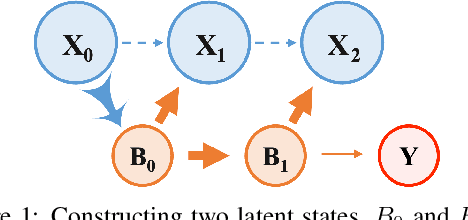

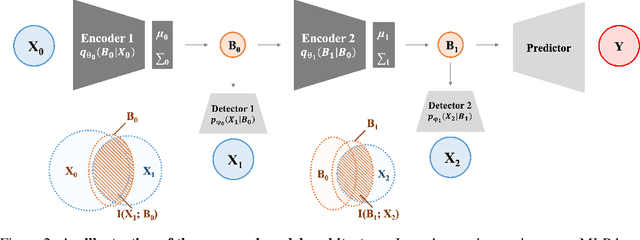

Abstract:Integrating and processing information from various sources or modalities are critical for obtaining a comprehensive and accurate perception of the real world in autonomous systems and cyber-physical systems. Drawing inspiration from neuroscience, we develop the Information-Theoretic Hierarchical Perception (ITHP) model, which utilizes the concept of information bottleneck. Different from most traditional fusion models that incorporate all modalities identically in neural networks, our model designates a prime modality and regards the remaining modalities as detectors in the information pathway, serving to distill the flow of information. Our proposed perception model focuses on constructing an effective and compact information flow by achieving a balance between the minimization of mutual information between the latent state and the input modal state, and the maximization of mutual information between the latent states and the remaining modal states. This approach leads to compact latent state representations that retain relevant information while minimizing redundancy, thereby substantially enhancing the performance of multimodal representation learning. Experimental evaluations on the MUStARD, CMU-MOSI, and CMU-MOSEI datasets demonstrate that our model consistently distills crucial information in multimodal learning scenarios, outperforming state-of-the-art benchmarks. Remarkably, on the CMU-MOSI dataset, ITHP surpasses human-level performance in the multimodal sentiment binary classification task across all evaluation metrics (i.e., Binary Accuracy, F1 Score, Mean Absolute Error, and Pearson Correlation).
Exploring Neuron Interactions and Emergence in LLMs: From the Multifractal Analysis Perspective
Feb 14, 2024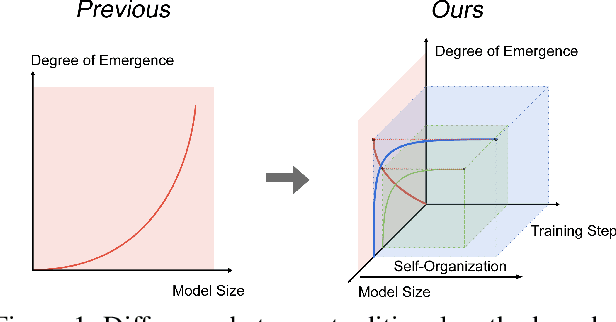


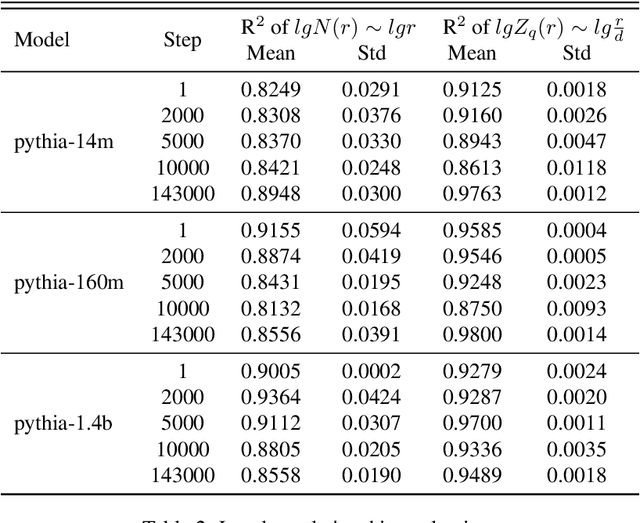
Abstract:Prior studies on the emergence in large models have primarily focused on how the functional capabilities of large language models (LLMs) scale with model size. Our research, however, transcends this traditional paradigm, aiming to deepen our understanding of the emergence within LLMs by placing a special emphasis not just on the model size but more significantly on the complex behavior of neuron interactions during the training process. By introducing the concepts of "self-organization" and "multifractal analysis," we explore how neuron interactions dynamically evolve during training, leading to "emergence," mirroring the phenomenon in natural systems where simple micro-level interactions give rise to complex macro-level behaviors. To quantitatively analyze the continuously evolving interactions among neurons in large models during training, we propose the Neuron-based Multifractal Analysis (NeuroMFA). Utilizing NeuroMFA, we conduct a comprehensive examination of the emergent behavior in LLMs through the lens of both model size and training process, paving new avenues for research into the emergence in large models.
Neuro-Inspired Hierarchical Multimodal Learning
Sep 27, 2023Abstract:Integrating and processing information from various sources or modalities are critical for obtaining a comprehensive and accurate perception of the real world. Drawing inspiration from neuroscience, we develop the Information-Theoretic Hierarchical Perception (ITHP) model, which utilizes the concept of information bottleneck. Distinct from most traditional fusion models that aim to incorporate all modalities as input, our model designates the prime modality as input, while the remaining modalities act as detectors in the information pathway. Our proposed perception model focuses on constructing an effective and compact information flow by achieving a balance between the minimization of mutual information between the latent state and the input modal state, and the maximization of mutual information between the latent states and the remaining modal states. This approach leads to compact latent state representations that retain relevant information while minimizing redundancy, thereby substantially enhancing the performance of downstream tasks. Experimental evaluations on both the MUStARD and CMU-MOSI datasets demonstrate that our model consistently distills crucial information in multimodal learning scenarios, outperforming state-of-the-art benchmarks.
 Add to Chrome
Add to Chrome Add to Firefox
Add to Firefox Add to Edge
Add to Edge